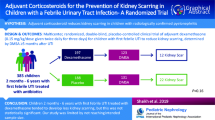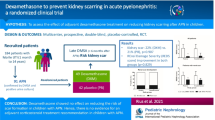Abstract
Cytokines play a major role in renal scar formation following febrile urinary tract infection (UTI). We investigated the role of dexamethasone combined with antibiotics in diminishing urinary interleukin-6 (UIL-6) and UIL-8 concentrations during the acute phase of pyelonephritis compared with standard antibiotic therapy. UIL-6 and UIL-8 concentrations were determined by enzyme immunoassay in 34 children with pyelonephritis who were treated with ceftriaxone plus dexamethasone (case group) and in 20 patients with the same diagnosis treated with ceftriaxone alone (control group). Urine samples were obtained at the time of presentation prior to drug administration and at follow-up 72 h after initiation of medication. Creatinine concentrations were also determined, and cytokine/creatinine ratios were calculated to standardize samples. Differences between cytokine/creatinine ratios in initial and follow-up urine samples were significant in the case group (P < 0.001) but not for controls. In addition, combined antibiotic and dexamethasone significantly decreased UIL-6 and UIL-8 concentrations compared with antibiotic alone (P < 0.05). We conclude that dexamethasone combined with antibiotics significantly decreases UIL-6 and UIL-8 levels in patients with acute pyelonephritis. This suggests that the clinical use of corticosteroids may prevent scar formation following febrile UTI.


Similar content being viewed by others
References
Coulthard MG, Lambert HJ, Keir MJ (1997) Occurrence of renal scars in children after their first referral for urinary tract infection. BMJ 315:918–919
Dick PT, Feldman W (1996) Routine diagnostic imaging for childhood urinary tract infections: a systematic overview. J Pediatr 128:15–22
Lin KY, Chiu NT, Chen MJ, Lai CH, Huang JJ, Wang YT, Chiou YY (2003) Acute pyelonephritis and sequelae of renal scar in pediatric first febrile urinary tract infection. Pediatr Nephrol 18:362–365
Lerner GR (1994) Urinary tract infections in children. Pediatr Ann 23:463–473
Funfstuck R, Franke S, Hellberg M, Knofel B, Straube E, Sommer M, Hacker J (2001) Secretion of cytokines by uroepithelial cells stimulated by Escherichia coli and Citrobacter spp. Int J Antimicrob Agents 17:253–258
Kassir K, Vargas-Shiraishi O, Zaldivar F, Berman M, Singh J, Arrieta A (2001) Cytokine profiles of pediatric patients treated with antibiotics for pyelonephritis: potential therapeutic impact. Clin Diagn Lab Immunol 8:1060–1063
Rao WH, Evans GS, Finn A (2001) The significance of interleukin 8 in urine. Arch Dis Child 85:256–262
Agace W, Connell H, Svanborg C, Harry L, Mobley T, Warren JW (1996) Host Resistance to Urinary Tract Infection: Molecular Pathogenesis and Clinical Management. Washington DC: American Society for Microbiology, pp 221–243
Agace W, Hedges S, Ceska M, Svanborg C (1993) Interleukin-8 and the neutrophil response to mucosal gram-negative infection. J Clin Invest 92:780–785
Agace W, Hedges S, Andersson U, Andersson J, Ceska M, Svanborg C (1993) Selective cytokine production by epithelial cells following exposure to Escherichia coli. Infect Immun 61:602–609
Beutler A, Cerami I, Figari S, Palladino MA, O’Conner V (1986) Tumor necrosis factor (cachectin) is an endogenous pyrogen and induces production of interleukin-1. J Exp Med 163:1433–1450
Akira S, Taga T, Kishimoto T (1993) Interleukin-6 in biology and medicine. Adv Immunol 54:1–78
Baggiolini M, Walz A, Kunkel SL (1989) Neutrophil-activating peptide-1/interleukin 8, a novel cytokine that activates neutrophils. J Clin Invest 84:1045–1049
Jantausch BA, O’Donell R, Wiedermann BL (2000) Urinary interleukin-6 and interleukin-8 in children with urinary tract infection. Pediatr Nephrol 15:236–240
Roilides E, Papachristou F, Gioulekas E, Tsaparidou S, Karatzas N, Sotiriou J, Tsiouris J (1999) Increased urine interleukin-6 concentrations correlate with pyelonephritic changes on 99 mTc-dimercaptosuccinic acid scans in neonates with urinary tract infections. J Infect Dis 180:904–907
Sakumoto M, Matsumoto T, Mochida O, Takahashi K, Sakuma S, Kumazawa J (1998) Urinary concentrations of cytokines in patients with pyelonephritis and cystitis. J Infect Chemother 4:24–27
Tullus K, Fituri O, Burman L, Wretlind B, Brauner A (1994) Interleukin-6 and interleukin-8 in the urine of children with acute pyelonephritis. Pediatr Nephrol 8:280–284
Sharifian M, Karimi A, Gachkar L, Fallah F, Jadali F, Armin SH, Fahimzad AR, Tabatabaei SR (2006) Interleukin 1 and 6 in children with acute pyelonephritis. Emirates Med J 24:219–222
Fussell EN, Roberts JA (1984) The ultrastructure of acute pyelonephritis in the monkey. J Urol 133:179–183
Shimamura T (1981) Mechanisms of renal tissue destruction in an experimental acute pyelonephritis. Exp Mol Pathol 34:34–42
Glauser MP, Lyons JM, Braude AI (1978) Prevention of chronic experimental pyelonephritis by suppression of acute suppuration. J Clin Invest 61:403–407
Glauser MP, Meylan P, Bille J (1987) The inflammatory response and tissue damage: the example of renal scars following acute renal infection. Pediatr Nephrol 1:615–622
Pohl HD, Rushton HG, Park JS, Chandra R, Majd M (1999) Adjunctive oral corticosteroids reduce renal scarring: the piglet model of reflux and acute experimental pyelonephritis. J Urol 162:815–820
Imamoglu M, Cay A, Cobanoglu U, Bahat E, Karahan C, Tosun I, Sarihan H (2006) Effects of melatonin on suppression of renal scarring in experimental model of pyelonephritis. Urology 67:1315–1319
Huang A, Palmer LS, Hom D, Anderson AE, Kushner L, Franco I (1999) Ibuprofen combined with antibiotics suppresses renal scarring due to ascending pyelonephritis in rats. J Urol 162:1396–1398
Meylan PR, Glauser MP (1988) Failure of dexamethasone to prevent polymorphonuclear leukocyte infiltration during experimental acute exudative pyelonephritis and to reduce subsequent chronic scarring. J Infect Dis 157:480–485
Sener G, Tugtepe H, Velioglu-Ogunc A, Cetinel S, Gedik N, Yegen BC (2006) Melatonin prevents neutrophil-mediated oxidative injury in Escherichia coli-induced pyelonephritis in rats. J Pineal Res 41:220–227
Biyikli NK, Tugtepe H, Sener G, Velioglu-Ogunc A, Cetinel S, Midillioglu S, Gedik N, Yegen BC (2006) Oxytocin alleviates oxidative renal injury in pyelonephritic rats via a neutrophil-dependent mechanism. Peptides 27:2249–2257
Matsumoto T, Haraoka M, Mizunoe Y, Kubo S, Takahashi K, Tanaka M, Kumazawa J (1993) Renal scarring is enhanced by phorbol myristate acetate following infection with bacteria with mannose-sensitive pili. Nephron 64:405–409
Tugtepe H, Sener G, Cetinel S, Velioglu-Ogunc A, Yegen BC (2007) Oxidative renal damage in pyelonephritic rats is ameliorated by montelukast, a selective leukotriene CysLT1 receptor antagonist. Eur J Phamacol 557:69–75
Haraoka M, Matsumoto T, Mizunoe Y, Ogata N, Takahishi K, Kubo S, Tanaka M, Kumazawa J (1993) Effect of prednisolone on renal scarring in rats following infection with Serratia marcescens. Ren Fail 15:567–571
Haraoka M, Matsumoto T, Takahashi K, Kubo S, Tanaka M, Kumazawa J (1994) Suppression of renal scarring by prednisolone combined with ciprofloxacin in ascending pyelonephritis in rats. J Urol 151:1078–1080
Matsumoto T, Mizunoe Y, Ogata N, Tanaka M, Takahashi K, Kumazawa J (1992) Antioxidant effect on renal scarring following infection by mannose-sensitive-piliated bacteria. Nephron 60:210–215
Matsumoto T, Takahashi K (2000) Prevention of renal scarring following bacterial pyelonephritis. Infect Urol 13:19–21
Roberts JA, Roth JK, Domingue G, Lewis RW, Kaack B, Baskin G (1983) Immunology of pyelonephritis in the primate model. VI. Effect of complement depletion. J Urol 129:193–197
Yagmurlu A, Boleken ME, Ertoy D, Ozsan M, Gokcora IH, Dindar H (2003) Preventive effect of pentoxiphylline on renal scarring in rat model of pyelonephritis. Urology 61:1037–1041
Kavukcu S, Soylu A, Turkmen M, Sarioglu S, Buyukgebiz B, Gure A (1999) The role of vitamin A in preventing renal scarring secondary to pyelonephritis. BJU Int 83:1055–1059
Matsumoto T, Haraoka M, Mizunoe Y, Takahishi K, Kubo S, Sakumoto M, Tanaka M, Kumazawa J (1995) Preventive effect of ulinastatin on renal scarring in rat model of pyelonephritis induced by direct or ascending infection with Serratia marcescens or Escherichia coli. Nephron 69:65–70
Mochida O, Matsumoto T, Mizunoe Y, Sakamoto M, Abe J, Kumazawa J (1998) Preventive effect of dapsone on renal scarring following mannose-sensitive piliated bacterial infection. Chemotherapy 44:36–41
Tardif M, Beauchamp D, Bergeron Y, Lessard C, Gourde P, Bergeron MG (1994) L-651,392, a potent leukotriene inhibitor, controls inflammatory process in Escherichia coli pyelonephritis. Antimicrob Agents 38:1555–1560
Tullus K, Fituri O, Linne T, Escobar-Billing R, Wikstad I, Karlsson A, Burman LG, Wretlind B, Brauner A (1994) Urine interleukin-6 and interleukin-8 in children with acute pyelonephritis, in relation to DMSA scintigraphy in the acute phase and at 1-year follow-up. Pediatr Radiol 24:13–15
Lebel MH, Freij BJ, Syrogiannopoulos GA, Chrane DF, Hoyt MJ, Stewart SM, Kennard BD, Olsen KD, McCracken GH (1988) Dexamethasone therapy for bacterial meningitis: results of two double-blinded, placebo-controlled trials. N Engl J Med 319:964–971
Benson M, Jodal U, Agace W, Hellstrom M, Marild S, Roseberg S, Sjostrom M, Weltergren B, Jonsson S, Svanborg C (1996) Interleukin (IL)-6 and IL-8 in children with febrile urinary tract infection and asymptomatic bacteriuria. J Infect Dis 174:1080–1084
Ko YC, Mukaida N, Ishiyama S, Tokue A, Kawai T, Matsushima K, Kasahara T (1993) Elevated interleukin-8 levels in the urine of patients with urinary tract infections. Infect Immunol 61:1307–1314
Galanakis E, Bitsori M, Dimitriou H, Giannakopoulou C, Karkavitsas NS, Kalmanti M (2007) Serum and urine interleukin-6 and transforming growth factor-beta-1 in young infants with pyelonephritis. Int Urol Nephrol 39:581–585
Acknowledgment
Many thanks to the personnel of the Pediatric Infectious Research Center (PIRC) and the nephrology ward of Mofid Children’s Hospital for their contribution to this study.
Author information
Authors and Affiliations
Corresponding author
Rights and permissions
About this article
Cite this article
Sharifian, M., Anvaripour, N., Karimi, A. et al. The role of dexamethasone on decreasing urinary cytokines in children with acute pyelonephritis. Pediatr Nephrol 23, 1511–1516 (2008). https://doi.org/10.1007/s00467-008-0864-4
Received:
Revised:
Accepted:
Published:
Issue Date:
DOI: https://doi.org/10.1007/s00467-008-0864-4




